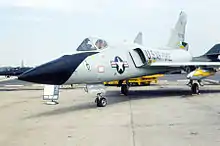Cornfield Bomber
The "Cornfield Bomber" is the nickname given to a Convair F-106 Delta Dart, operated by the 71st Fighter-Interceptor Squadron of the United States Air Force. In 1970, during a training exercise, it made an unpiloted landing in a farmer's field in Montana, suffering only minor damage, after the pilot had ejected from the aircraft. The aircraft, recovered and repaired, was returned to service, and is currently on display at the National Museum of the United States Air Force.
| Cornfield Bomber | |
|---|---|
 | |
| The "Cornfield Bomber" in its resting place, a frozen Montana field | |
| Type | F-106A-100-CO Delta Dart |
| Manufacturer | Convair |
| Serial | 58-0787 |
| Owners and operators | United States Air Force |
| In service | 1958–1988[1] |
| Fate | On display |
| Preserved at | National Museum of the United States Air Force in Dayton, Ohio |
History

The individual aircraft was manufactured by Convair in 1958 and received the tail number 58-0787. It served with 71st Fighter-Interceptor Squadron based at Malmstrom Air Force Base adjacent to Great Falls, Montana. During a routine training flight conducting aerial combat maneuvers on February 2, 1970, the aircraft entered a flat spin. The pilot, Captain Gary Faust,[2] attempted to recover, deploying the aircraft's drag chute as a last resort;[3] recovery proved to be impossible. Faust fired his ejection seat and escaped the stricken aircraft at an altitude of 15,000 feet (4,600 m).[4]
The reduction in weight and change in center of gravity caused by the removal of the pilot,[5] coupled with the blast force of his seat rocketing out of the plane pushing the nose of the aircraft down,[2] which had been trimmed by Faust for takeoff and idle throttle, caused the aircraft to recover from the spin.[5] One of the other pilots on the mission was reported to have radioed Faust during his descent by parachute that "you'd better get back in it!".[3] From his parachute, Faust watched incredulously as the now-pilotless aircraft descended and skidded to a halt in a farmer's field near Big Sandy, Montana.[5] Faust drifted into the nearby mountains. He was later rescued by local residents using snowmobiles.[3][4]
Shortly thereafter the local sheriff and local residents arrived at the scene of the crash. The thrust from the still-idling jet engine allowed the aircraft to slowly drift on its belly along a field.[2] The sheriff, having contacted the air base, was informed that he should simply allow the jet to run out of fuel, which occurred an hour and forty-five minutes later without further incident.[3] A recovery crew from McClellan Air Force Base arrived on the scene and began to dismantle the aircraft, removing its wings for transport aboard a railroad flat car. The damage to the aircraft was minimal; indeed, one officer on the recovery crew is reported to have stated that if there were any less damage he would have simply flown the aircraft out of the field.[3][4]
Preservation

Following its misadventure, the "Cornfield Bomber" was repaired and returned to service, operating with the 49th Fighter-Interceptor Squadron, the final Air Force unit to operate the F-106.[3] Faust flew the aircraft again in 1979 while training at Tyndall Air Force Base.[6] Upon its retirement, it was presented to the National Museum of the United States Air Force in August 1986, where it remains on display.[1][5]
References
Notes
- "Fact Sheets – Convair F-106A Delta Dart". National Museum of the United States Air Force. Retrieved 13 July 2016.
- HW (2 Feb 2013). "The Cornfield Bomber". Retrieved 29 September 2015.
- Grier 2009
- "58-0787 Pilot-less Landing". f-106deltadart.com. Archived from the original on 6 January 2011. Retrieved 31 December 2010.
- Skaarup 2003, p. 84.
- Kurtz, Nicholas (2013-10-17). AMAZING! Fighter Jet Lands Itself AFTER Pilot Ejects! The Cornfield Bomber!. National Museum of the United States Air Force, Wright-Patterson Air Force Base, Ohio: YouTube. Archived from the original on 2017-04-19. Retrieved 2017-05-30.
Bibliography
- Grier, Peter. "Gary, You Better Get Back In It!". Air Force Magazine. Retrieved 1 January 2011.
- Skaarup, Harold A. (2003). Ohio Warbird Survivors 2003: A Handbook on Where to Find Them. Lincoln, NE: iUniverse. ISBN 0-595-27304-1. Retrieved 2011-01-01.
External links
| Wikimedia Commons has media related to Cornfield Bomber incident. |
- Short documentary on the Cornfield Bomber on AVweb
- National Museum of the Airforce videos page, with pilot interview
- Cornfield Bomber video, National Museum of the U.S. Air Force, YouTube